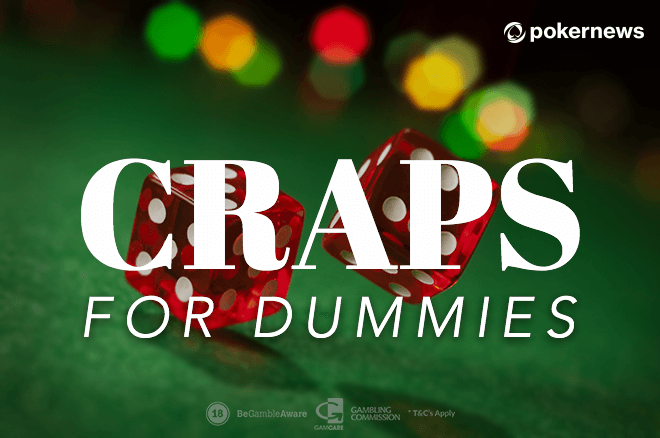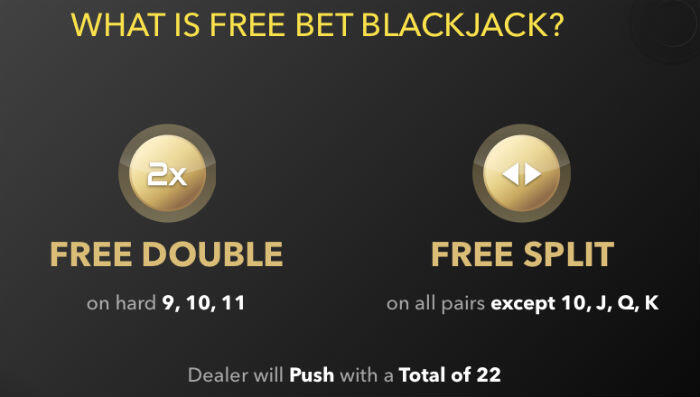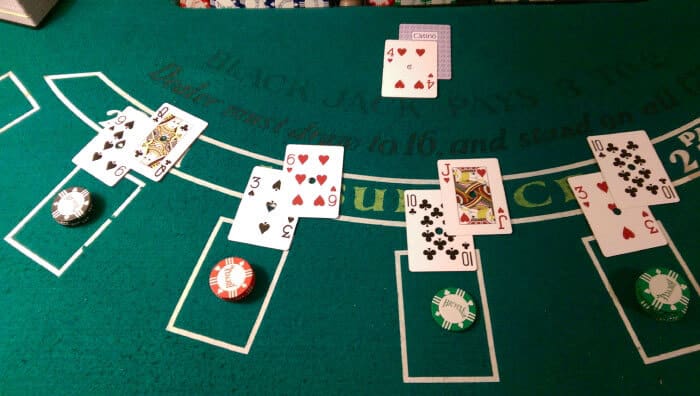Free Bet Blackjack Strategy
If you happen to enjoy Blackjack Switch, there is a good chance you might get intrigued by Free Bet Blackjack. Both variations were invented by professional gambler Geoff Hall, a highly acclaimed figure in the landbased gambling circles.
Mat a bet to play against the dealer. You and the dealer will get two starting cards, as in standard blackjack. You may also make a bet on the optional Pot of Gold wager. You may free split any pairs, except for 10-value cards. Free re-splitting is allowed. You may free double any two-card hard 9, 10, or 11. Basic blackjack strategy is simple to understand, with only minor alterations for different variations of the game. For inexperienced players however, it can be initially tricky to learn. We recommend that new players keep our (downloadable and printable) blackjack strategy chart handy when learning, or practice with free blackjack games. Watch More Content Here!!Twitch: (Require to Play Blackjack with us on Twit. The Perfect Pairs and 21+3 side bets are also available across live dealer casinos powered by the Evolution Gaming software. They can be found in live variations like Blackjack Party, Free Bet Blackjack, and Infinite Blackjack, among others. Any time the count is a minus number or zero, make a bet of one unit. When the count is positive, bet more than one unit. By betting more when you have the edge, and less when you don't, you can actually beat the casino at blackjack.
Hall first introduced Free Bet Blackjack in June 2012 at the Golden Nugget Casino in downtown Las Vegas and himself deems it his most successful creation to this date. The game mostly plays like conventional blackjack with two major differences. Players get to double down and split on certain two-card hand values for free.
Basic Rules and Payouts in Free Bet Blackjack
Free Bet Blackjack is normally dealt out of a six-deck shoe and requires the dealer to hit soft totals of 17. Minimum bets are typically either $5 or $10. The round starts with players posting their chips in the betting circles corresponding to their spots on the table.
Once bets are posted, all participants receive two face-up cards, except the dealer whose second card is dealt face-down. A starting hand of an Ace and a ten-value card is an instant winner and returns a payout of 3 to 2 although an increasing number of gambling halls choose to cut down the odds for blackjacks to 6 to 5. Regular winning hands pay out even money.

Players have a choice from the usual playing decisions like hitting, standing, doubling down, and splitting. Surrendering a hand is no longer permitted in Free Bet Blackjack.
The free doubling down and splitting rules are outlined in the sections below but they come at a cost. Instead of busting on hands that total 22, the dealers in Free Bet Blackjack push with the players. Thus, if the player’s hand totals 21 or less and the dealer has a total of 22, the player’s wager is considered a tie.
Payouts for the Push 22 Side Bet
Some gambling halls like San Diego’s Pala Casino give players the opportunity to earn extra money with the Push 22 side bets. The payouts for these optional wagers are as follows:
- 50 to 1 for a dealer with suited cards that total 22
- 20 to 1 for a dealer hand of 22 that consists of cards of the same color
- 8 to 1 for any hand combination of the dealer that totals 22, regardless of suit and color
Doubling Down in Free Bet Blackjack
Regular doubling down is permitted on any two-card total. However, the player gets to double down for free on two-card hands of 9, 10, and 11. In this instance, the dealer matches the player’s initial wager with a free bet chip and deals one more card to the hand.
If the player wins, the dealer pays the successful double with real money. If the dealer wins, the player loses only the original bet they have posted and the free-play chips are removed from the felt. When the two push, the player gets their original wager back. Free doubling is also allowed after the player splits pairs.
Splitting in Free Bet Blackjack
At Free Bet Blackjack tables, players can split for free all pairs with the exception of 10s, although splitting 4s at no cost was also prohibited initially. The pair is then divided into two separate hands and a card is automatically drawn to each one.
The hands are played one at a time, with players having the option to hit, stand, double for free, or resplit for free. Resplitting is possible to up to four individual hands, including those consisting of Aces. Respectively, a free-bet chip is used for each split hand. Should the player win, their free chip is replaced with a real chip that equals the amount of the initial wager. If the dealer wins, they collect only the players’ original bet.
House Edge and RTP
When Free Bet Blackjack first hit the floors of Las Vegas casinos, players had the opportunity to exercise the late surrender decision, i.e. to fold their starting hands in exchange for half of their original wagers. However, it was soon established this led to a significant reduction in the house edge, which dropped to 0.21% only.
Gambling halls then decided to boost their own advantage by removing the surrender option altogether. The rules outlined above presently yield a house edge of around 1%, which is still rather decent for a game where you get to double down and split for free. Respectively, this corresponds to a long-term theoretical return-to-player percentage of 99% at 3-to-2 tables.
Strategy and Tips for Free Bet Blackjack
The optimal strategy here bears a number of similarities with that for conventional blackjack but there are several exceptions you need to have in mind when you attack the Free Bet Blackjack tables. The first exception is that players should split all pairs for free except those consisting of 5s where they should double at no cost instead.
Keep in mind splitting 10s is generally a bad idea. If you insist on doing it, nevertheless, remember the free split rule does not stand on paired 10s and you will have to pay for this decision. You should also double down for free on any two-card total of 9, 10, and 11, regardless of what the dealer’s exposed card is.
Have you ever thought that you could get an advantage over the house just by altering your bet sizes or what you bet on at the right times? Many betting strategies exist that claim to be able to do just that. They claim that by changing your bets based on recent results, you can gain an edge over the house in a game (like blackjack) that normally has a house edge for the casino.
Are these systems for real? Well, that depends. It might be best to divide betting strategies into two categories, just to separate the effective methods from those that are ineffective (and sometimes sold as scams). Any betting strategy that claims to be able to structure bets that all have a house edge and somehow make you a winner is bound to disappoint you, because it simply isn’t possible to take multiple bets with negative expectations and come out with an overall positive expectation. We’ll call these betting systems. On the other hand, betting strategies that offer you ways to maximize your advantage or limit your risk of going broke when you already have the edge can be an important part of a professional blackjack player’s overall strategy.
Editor’s Picks for Best Online Blackjack in 2020
- RTG Blackjack
- ViG Live Blackjack
- BTC Bonuses
- Live Dealer Blackjack
- 24/7 Live Support
- Trusted since 2007

- Online and mobile blackjack
- Great for U.S. based players
- New and fresh
- Classic & progressive blackjack
- Weekly blackjack tournaments
- Great for U.S. based players
$4,000
Betting Systems
Over the years, many people have tried to come up with betting systems that could beat various casino games. They appeal to a lot of players, especially those who don’t understand the math behind gambling. Often, they make some sort of intuitive sense, which leads people to come up with reasons to believe that their system must work. However, as we said earlier, no betting system can turn a series of bets with a house edge into a system that has an edge for the player.
Martingale System
Let’s take a look at one common betting system and see how it works – and why it doesn’t work.
The Martingale System is probably the best known casino gambling system in the world, and also the most popular. It is incredibly simple to use, and seems to offer a “can’t lose” way of playing games that offer bets that are around 50/50 propositions.
In the Martingale System, the player begins by making a small bet – usually the table minimum. If the player wins, they make that same small bet again. If they lose, they instead double their bet. If the player loses again, they double their bet again. The player continues doubling their bet until they win, at which point they revert to their original small bet size.
This means that in each iteration of the Martingale, the player will win the minimum bet size. For instance, a player might win their original $5 bet, thus profiting $5. Or they might have the following sequence:
Lose $5
Lose $10
Lose $20
Win $40

Meaning they would lose $35 but then win $40, thus coming out $5 ahead yet again.
So, why doesn’t this work? Eventually, you will hit a string of losses that will be catastrophic, wiping out your bankroll and any small profits you’ve made so far. Many players believe a long string of losses like that is unlikely, and they’re right; however, it will happen often enough that the casino retains the house edge they had at the beginning of the game. Table limits make this occur even faster, meaning you’ll quickly hit a point where you simply can’t double your bet anymore.
For instance, take a table with a minimum bet of $5 and a maximum bet of $500. The player can double six times:
Free Bet Blackjack Strategy
$5
$10
$20
$40
$80
$160
$320
After that, the player cannot double to $640. For the moment, let’s do an example with single-zero roulette, since the math is easier. If the player makes a bet on one of the even money bets – say, betting on black – they have 18 ways to win, and 19 ways to lose. This means the player will lose 51.3% of the time. This also means that at any given time, there’s about a 0.94% chance that they’ll run into a 7-spin losing streak, putting them in the position of not being able to double. That’s only one time in 106 (we’re rounding a bit, but that’s roughly accurate), but that’s still not good enough to make the Martingale work! The player will make $525 in the 105 times they win, but they’ll lose $635 the one time they hit a 7-spin losing streak.
The math for blackjack is a bit more complicated, since not all bets pay even money, you’ll sometimes have to spend extra money to double down or split, and the player wins fan less than half of the hands (especially when taking pushes into account). However, the principle remains the same – the player cannot overcome a series of bets that have a house edge simply by creatively structuring their bets.
Betting Strategies and the Kelly Criterion
Free Bet Blackjack Strategy Chart
On the other hand, can betting strategies help you when you already have an advantage? The answer is emphatically yes! In fact, betting strategy is critical for anyone who wants to be a profitable blackjack player. For instance, card counting relies heavily on betting strategy, as the player must bet more when he has the advantage, and less (or not at all) when things swing in the dealer’s favor.
But betting strategy can be much more complex than that. While it’s obvious that players should bet more when they have an edge, it’s harder to figure out how much they should bet on a typical hand. Figuring that out requires the player to take into account the size of their bankroll, as well as the size of their edge over the house.
One method of figuring out the optimal bet size is to use the Kelly Criterion. The Kelly Criterion is an attempt to maximize the rate at which a player can make money when they have an edge without having a significant risk of ruin. The formula is basically as follows:
f = (bp-q)/b
f = the portion of the player’s bankroll they should wager on each bet.
b = the odds the player is receiving on each wager (b to 1).
p = the probability of winning the wager.
q = the probability of losing the wager.
For instance, imagine a game where the player receives even money odds (1-1), but feels as though they have a 55% chance of winning each hand. This would make the formula look like this:
f = (1*.55 – .45)/1
f = .1
In this case, the Kelly Criterion suggests betting .1, or 10% of the player’s bankroll, on each bet in order to maximize the growth-rate of the player’s bankroll. Of course, players rarely have such a huge edge, and blackjack is a bit more complex since the player sometimes wins differing amounts, and sometimes is forced to wager additional money on a hand. We’ll go into more detail on how to use the Kelly Criterion when playing blackjack in our article on Bankroll Management.